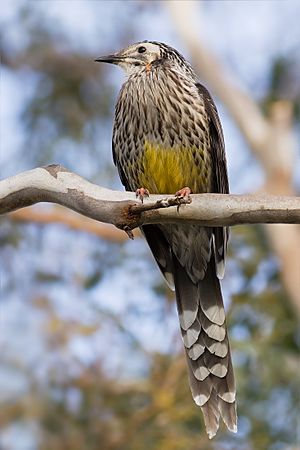Yellow wattlebird facts for kids
Quick facts for kids Yellow wattlebird |
|
|---|---|
 |
|
| Conservation status | |
| Scientific classification | |
| Genus: |
Anthochaera
|
| Species: |
paradoxa
|
| Synonyms | |
|
Corvus paradoxus Daudin, 1800 |
|
The yellow wattlebird (Anthochaera paradoxa) is a unique bird from the honeyeater family. People sometimes call it the long wattlebird or the Tasmanian wattlebird. It is the largest of all honeyeaters.
Contents
Scientific Name
A French scientist named François Marie Daudin first described this bird in 1800. He called it Corvus paradoxus back then.
The first part of its scientific name, Anthochaera, comes from old Greek words. Anthos means 'flower' and khairō means 'enjoy'. So, it's like 'flower-enjoyer'. The second part, paradoxa, means 'strange' or 'extraordinary'. This name fits because of its unique look!
What Does It Look Like?
The yellow wattlebird is a large bird, usually about 37.5–45 centimetres (14.8–17.7 in) long. It gets its name from the special fleshy growths called wattles that hang from its cheeks. These wattles are yellow-orange and can look quite long. They even get brighter during the breeding season!
This bird has a slim body and a short, strong beak. Its face is white, and the top of its head has black streaks. Its wings are dark, and its belly is yellow. The upper parts of its body are grey to dusky brown.
Female yellow wattlebirds are much smaller than males. Young birds have smaller wattles, a lighter head, and a browner belly compared to adult birds. The yellow wattlebird looks a bit like the little wattlebird and the red wattlebird.
Where Do Yellow Wattlebirds Live?
Yellow wattlebirds are very common in Tasmania, especially in the eastern and central parts. They are not often seen on King Island. There have been a couple of possible sightings in southern Mornington Peninsula in Victoria, but these are not fully confirmed.
These birds live in many different places. You can find them in dry and wet forests, from sea level up to high mountain areas. They like coastal heaths, forests, and gardens, especially near Eucalyptus trees. They also live in mountain shrubberies and open woodlands, particularly where Banksia plants grow. Sometimes, you might even spot them on golf courses, in orchards, parks, and gardens.
How Do They Behave?
Yellow wattlebirds are very active and fly strongly. They are quite comfortable around people and often visit gardens looking for food.
Their calls are loud and harsh. Some people say their calls sound like someone coughing or belching. They also make a gurgling growk or a repeated clok sound.
What Do They Eat?
Yellow wattlebirds mostly eat nectar from eucalyptus and banksia trees. They also enjoy fruit, insects, spiders, honeydew (a sweet liquid from plants), honey bees, and manna (crystallized plant sap). They look for food everywhere, from the ground to the tops of trees.
The amount of eucalyptus nectar can change a lot each year. This means the yellow wattlebirds might move around to find enough food. Unusual weather can sometimes reduce their food supply, which is a challenge for them. Yellow wattlebirds help pollinate eucalyptus trees by carrying pollen on their beaks or head feathers.
Reproduction
Yellow wattlebirds form pairs for breeding and protect their nesting areas from other birds. The female builds the nest by herself. It is a large, open, saucer-shaped nest made of twigs and bark, held together with wool. The inside is lined with soft wool and grass. These nests can be up to 13 centimetres (5.1 in) high and are found in trees or shrubs.
Yellow wattlebirds usually lay 2 to 3 eggs. The eggs are salmon-red with spots and blotches of red-brown, purplish-red, and blue-grey. Both the male and female birds take turns sitting on the eggs to keep them warm. They also both help feed the young birds once they hatch.
See also
 In Spanish: Mielero ventriamarillo para niños
In Spanish: Mielero ventriamarillo para niños


